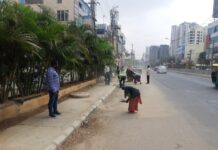
Mumbai, The Maharashtra Government on Friday invited global tenders for the ambitious Rs 20,000-crore Dharavi Redevelopment Project (DRP) that will hope to transform and beautify what’s infamous as Asia’s largest slum in central parts of Mumbai.
The move comes a month after the state cabinet headed by Chief Minister Devendra Fadnavis on October 16 cleared plans to create a Special Purpose Vehicle for the project and resettle all existing inhabitants in the same areas.
This will be one of the similar redevelopment efforts undertaken for the region since 1972 including the Slum Improvement Projects in 1972 and 1976, Slum Upgradation of 1985, Slum Rehabilitation Scheme of 1995, and then the Dharavi Redevelopment Project of 2004.
However, Dharavi, sprawled over more than 104 hectares, remained the ugly underbelly of Mumbai, though surrounded on all sides by some of the poshest residential and commercial complexes in the country.
In the election year, the Slum Redevelopment Authority (SRA) has now floated global tenders for implementing the project with December 28 as last date of submission of bids, according to the CEO of SRA S.V.R. Srinivas and OSD for DRP.
Dharavi is located between the Western Railway’s Bandra-Matunga and Central Railway’s Sion-Matunga stations, comprising residential and business hubs with among the highest population density in the world and a massive turnover in the informal sector.
The Mithi River slices through a portion of it into the Mahim Creek and then onto the Arabian Sea, besides 28 temples, 11 mosques, six churches, 50 banks, 60 government schools, a mobile design museum, several slum tourism outfits, thriving criminal groups, and a tiny dilapidated fort.
The Riwa Fort or Kala Qilla was built during the tenure of the second Governor of Mumbai, Gerald Aungier (1669-1677), appointed by the British East India Company. The Riwa Fort was part of the larger Bombay Castle, earmarking the British-controlled norther portion of Bombay in the 17th century and functioned as a watchtower to safeguard the its domain from the Portuguese controlled, and later the Maratha-ruled Salsette Island.
Earlier, a huge swamp with marshy tracts, it was inhabited by a handful of Koli fisherfolk, considered the original inhabitants of Bombay. However, later large parts of it dried up after a small dam was constructed by the British, and the Kolis shifted to the coastal areas where they now reside.
Today, Dharavi is home to an estimated over 60,000 structures, around 70,000 families, mostly migrants from around the country – and the demographics of a ‘mini-India’, some 5,000 business establishments, 15,000 single-room or tiny factories churning out textiles to potteries to fabrication to leather good, plastic recycling and garbage segregation, making it a developer’s nightmare.
Many of the goods produced here are coveted by the rich and powerful and are exported all over the world.








